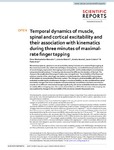Mostrar o rexistro simple do ítem
Temporal Dynamics of Muscle, Spinal and Cortical Excitability and Their Association With Kinematics During Three Minutes of Maximal-Rate Finger Tapping
| dc.contributor.author | Madinabeitia-Mancebo, Elena | |
| dc.contributor.author | Madrid López, Antonio | |
| dc.contributor.author | Jácome, M. A. | |
| dc.contributor.author | Cudeiro, Javier | |
| dc.contributor.author | Arias, Pablo | |
| dc.date.accessioned | 2020-03-11T09:46:38Z | |
| dc.date.available | 2020-03-11T09:46:38Z | |
| dc.date.issued | 2020-02-21 | |
| dc.identifier.citation | Madinabeitia-Mancebo, E., Madrid, A., Jácome, A. et al. Temporal dynamics of muscle, spinal and cortical excitability and their association with kinematics during three minutes of maximal-rate finger tapping. Sci Rep 10, 3166 (2020). https://doi.org/10.1038/s41598-020-60043-0 | es_ES |
| dc.identifier.issn | 2045-2322 | |
| dc.identifier.uri | http://hdl.handle.net/2183/25157 | |
| dc.description.abstract | [Abstract] We tested peripheral, spinal and cortical excitability during 3 minutes of unresisted finger tapping at the maximal possible rate, which induced fatigue. Subsequently, we studied the temporal dynamics of muscle fatigue, expressed in the tapping movement profile, and its relationship to neural systems using mixed model analyses. The tapping rate decreased by 40% over the duration of the task. The change in the amplitude of the range of motion was not significant. The excitability of the flexor and extensor muscles of the index finger was tested via evoked potentials obtained with various types of stimulation at various levels of the motor system. The change in spinal excitability with time was evaluated considering the simultaneous changes in muscle excitability; we also considered how spinal excitability changed over time to evaluate cortical excitability. Excitability in the flexor and extensor muscles at the different levels tested changed significantly, but similar excitability levels were observed at notably different tapping rates. Our results showed that only 33% of the decrease in the tapping rate was explained by changes in the excitability of the structures tested in the present work. | es_ES |
| dc.description.sponsorship | Pablo Arias is Principal Investigator- MINECO GRANT 2017. DEP2017-87601-R. Spanish Government Elena Madinabeitia has a PREDOC-GRANT-2015. Xunta de Galicia. Spain | |
| dc.language.iso | eng | es_ES |
| dc.publisher | Springer Nature | es_ES |
| dc.relation | info:eu-repo/grantAgreement/AEI/Plan Estatal de Investigación Científica y Técnica y de Innovación 2017-2020/DEP2017-87601-R/ES/ENTRENAMIENTO DE LA MARCHA COMBINADO CON ESTIMULACION CEREBRAL NO INVASIVA PARA REDUCIR LA FATIGA Y EL RIESGO DE CAIDAS EN MAYORES | |
| dc.relation.uri | https://doi.org/10.1038/s41598-020-60043-0 | es_ES |
| dc.rights | Atribución 4.0 Internacional | es_ES |
| dc.rights.uri | http://creativecommons.org/licenses/by/4.0/ | * |
| dc.title | Temporal Dynamics of Muscle, Spinal and Cortical Excitability and Their Association With Kinematics During Three Minutes of Maximal-Rate Finger Tapping | es_ES |
| dc.type | info:eu-repo/semantics/article | es_ES |
| dc.rights.access | info:eu-repo/semantics/openAccess | es_ES |
| UDC.journalTitle | Scientific Reports | es_ES |
| UDC.volume | 10 | es_ES |
| UDC.startPage | 3166 | es_ES |
Ficheiros no ítem
Este ítem aparece na(s) seguinte(s) colección(s)
-
GI-NEURO - Artigos [133]
-
INIBIC-NEURO - Artigos [48]






